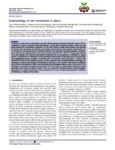Use este identificador para citar ou linkar para este item:
http://biblioteca.incaper.es.gov.br/digital/handle/item/2655Registro completo de metadados
| Campo DC | Valor | Idioma |
|---|---|---|
| dc.contributor.author | KROHLING, C. A. | pt_BR |
| dc.contributor.author | EUTRÓBIO, J. F. | pt_BR |
| dc.contributor.author | BERTOLAZI, A. A. | pt_BR |
| dc.contributor.author | DOBBS, L. B. | pt_BR |
| dc.contributor.author | CAMPOSTRINI, E. | pt_BR |
| dc.contributor.author | DIAS, T. | pt_BR |
| dc.contributor.author | RAMOS, A. C. | pt_BR |
| dc.date.accessioned | 2017-01-19T15:35:00Z | - |
| dc.date.available | 2017-01-19T15:35:00Z | - |
| dc.date.created | 2016 | pt_BR |
| dc.date.issued | 2017-01-19 | pt_BR |
| dc.identifier.other | 14932 | pt_BR |
| dc.identifier.uri | http://biblioteca.incaper.es.gov.br/digital/handle/item/2655 | - |
| dc.description | In nature, iron (Fe) occurs in abundance and ranks fourth among all elements on Earth?s surface. Still, its availability to plants is reduced, once this element is in the form of hydrated oxides, which can limit plant productivity and biomass production. On the other hand, in high concentrations, this essential micronutrient for the plants can become a toxic agent, increasing the environmental contamination. Fe is necessary for the maintenance of essential processes like respiration and photosynthesis, participating in the electron transport chain and in the conversion between Fe2+ and Fe3+, being a key element for carbon dioxide (CO2) fixation and, therefore, important for crop production of cultivated or natural species. The balance of Fe should be strictly controlled, because both its deficiency and its toxicity affect the physiological process of plants. In aerated soils Fe is present in the form of Fe3+, which is the oxidized form and is less available to plants, so these organisms have developed different strategies for absorption, transport and storage of Fe. Deficiency and excess of Fe correlate with local soil conditions and with the care adopted in plant nutrition during the phenological phases and/or in the course of its cultivation. In situations of excessive accumulation of Fe in tissues, an enhancement of hydroxyl radical generation (OH?) occurs by Fenton reaction. Here, we review the nutritional, genetic and ecophysiological aspects of uptake, translocation and accumulation of Fe ions in plants growing under conditions of deficiency or toxicity of this metal. | pt_BR |
| dc.language | pt_BR | pt_BR |
| dc.publisher | SOIL SCIENCE AND PLANT NUTRITION, v. 62, n. 1, p. 39?47, 2016. | pt_BR |
| dc.title | Ecophysiology of iron homeostasis in plants. | pt_BR |
| dc.type | Artigo de periódico (quando a biblioteca tiver o título do periódico) | pt_BR |
| dc.ainfo.id | 14114 | pt_BR |
| dc.ainfo.lastupdate | 2017-01-19 | pt_BR |
| dc.ainfo.depositante | Catia Ribeiro Barcelos | pt_BR |
| dc.subject.nalthesaurus | Respiration | pt_BR |
| dc.subject.nalthesaurus | Deficiency | pt_BR |
| dc.subject.nalthesaurus | Photosynthesis | pt_BR |
| dc.subject.nalthesaurus | Iron transporters | pt_BR |
| dc.subject.nalthesaurus | H+-ATPase | pt_BR |
| Aparece nas coleções: | Memória Técnica do Incaper  | |
Arquivos associados a este item:
| Arquivo | Descrição | Tamanho | Formato | |
|---|---|---|---|---|
| BRT-Ecophysiologyofironhomeostasisinplants-krohling.pdf | 827,44 kB | Adobe PDF |  Visualizar/Abrir |
Os itens no repositório estão protegidos por copyright, com todos os direitos reservados, salvo quando é indicado o contrário.
